Throwing Injuries in the Elbow in Children
Although elbow injuries can occur in anyone, young throwers are at highest risk. This is especially true for baseball pitchers, softball pitchers, quarterbacks and anyone who throws repetitively and forcefully before he or she has finished growing.
Description
Throwing a ball causes a lot of force across the elbow joint. In children, the ligaments and muscles may be strong, but the young growing bone may not be mature enough to withstand the stress.
Children’s bones differ from adults because they have bands of growing cartilage known as growth plates (physes) that are weaker than mature bone.
Throwing creates a lot of force that may damage the elbow and result in different injuries.
Little Leaguer’s Elbow
Also called
medial epicondylitis or
medial apophysitis. The bump on the inner side of the elbow is the medial epicondyle. This boney bump is known as the medial epicondyle or apophysis (growth center of the lower inner end of the humerus or arm bone). Ligaments and tendons attach to this bump and help control the elbow. Repetitive throwing stresses the ligaments and tendons that attach to this bump and weaken the area. This may result in pain in the inner elbow while throwing and tenderness when the bump is touched.
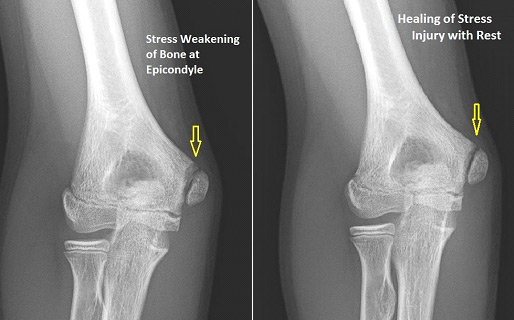
Continued throwing can cause tears in the ligaments or tendons and can even cause the bone to be pulled off.
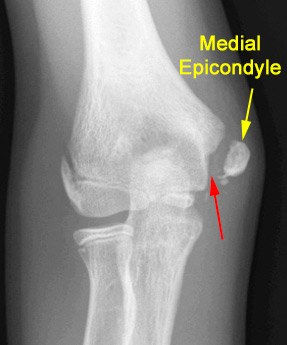 Figure. The medial epicondyle has been pulled off the elbow due to repeated throwing. The yellow arrow shows the abnormal gap between the medial epicondyle and the rest of the elbow. (courtesy of Texas Scottish Rite Sports Medicine)
Figure. The medial epicondyle has been pulled off the elbow due to repeated throwing. The yellow arrow shows the abnormal gap between the medial epicondyle and the rest of the elbow. (courtesy of Texas Scottish Rite Sports Medicine)
Osteochondritis Dissecans
Excessive throwing can lead to pain in the outer side of the elbow known as the lateral condyle.
During a throw, the inner side of the elbow is stretched, but the outside is compressed. As the lateral bones squeeze into each other, the young bone and cartilage may be damaged.
Throwers may complain of pain in their outer elbow and have trouble fully straightening the arm.
Repetitive throwing can cause fragments of bone and cartilage to crumble and even break off into the joint.
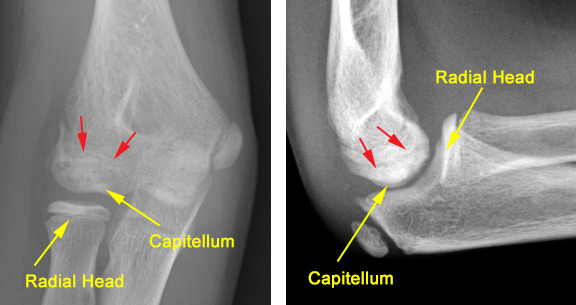 Figure. Repeated throwing leads to damage at the cartilage in the elbow. Red arrow show the osteochondritis dissecans. The radial head compresses against the capitellum with each throw. (courtesy of Texas Scottish Rite Sports Medicine)
Figure. Repeated throwing leads to damage at the cartilage in the elbow. Red arrow show the osteochondritis dissecans. The radial head compresses against the capitellum with each throw. (courtesy of Texas Scottish Rite Sports Medicine)
Doctor Examination
The doctor will often ask questions about how often and what type of pitches your child throws and when does the pain occur. He will also want to know if the elbow ever locks or gets stuck.
It is important to check the range of motion and compare it to the opposite side. Elbows that do not fully extend or straighten are likely to have an injury.
The doctor will push on different areas of the elbow to try to find the area that is most tender or painful.
X-rays are usually done because they can show if the bone is damaged. In some cases, the doctor may order an MRI to get more information about the severity of the damage.
Treatment - Nonsurgical
Treatment almost always starts with rest and stopping all throwing: Do Not Throw while in pain! Such rest applies to games, practices, and playing at home and with friends.
In mild cases, rest alone may heal the elbow. Occasionally, a removable elbow brace or splint may be recommended, but it is important to allow some elbow motion to prevent stiffness.
Treatment - Surgical
In severe cases and older children, surgery may be recommended to repair or remove loose bone fragments or cartilage.
Outcomes
If non-surgical treatment is effective, children can often return to throwing at 6-9 weeks. If surgery is required, recovery will be different depending on the procedure performed. It may take 6-9 months to return to competitive throwing.
More Information
Page QR Code:
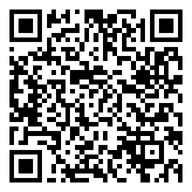
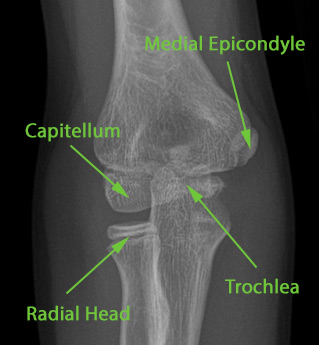 Q: Why do children’s elbows get injured during throwing?
Q: Why do children’s elbows get injured during throwing?
Throwing a ball causes a lot of force across the elbow joint. In children, the ligaments and muscles may be strong, but the young growing bone may not be mature enough to withstand the stress.
Q: What is Little Leaguer’s Elbow?
Repetitive throwing can cause the ligaments and tendons to pull on the medial side of the elbow resulting in pain on the boney bump known as the medial epicondyle or apophysis (growth center of the lower inner end of the humerus or arm bone)
Q: What is osteochondritis dissecans?
Throwing can cause the outer elbow to compress or squeeze bones together. Such pressure can damage blood flow to the immature cartilage and growing bone. This can cause areas of bone to die off and crumble.
Q: What is the best treatment for elbow pain in a young throwing athlete?
It is almost always best to stop throwing if a child describes any elbow pain. The forces generated during pitching are very high and can cause real damage to a growing elbow. It is better to miss a few weeks of pitching when young than to cause permanent damage that prevents any pitching when older.
Q: What are warning signs of elbow problems in a pitcher?
Pain and loss of full elbow extension are concerning. If your child cannot fully straighten the arm as much as the other side he or she should stop throwing and consider seeing a doctor.
Q: Why do coaches limit the number of pitches a child can throw?
Throwing puts a lot of stress across the elbow. It is important to give the body time to heal and recover from the damage caused by such forces. Pitch counts are one way to limit the damage. Throwing for multiple teams or with friends/family between games may lead to increased injuries.
Q: Is it bad if my child continues to throw if the elbow is painful?
Although some discomfort is not unusual for athletes, elbow pain in throwers can be a warning sign of a potential injury. Tissues such as muscles, ligaments, and cartilage may fatigue with continued throwing. If the inner elbow is sore and the thrower continues to throw, it may be possible to actually tear off pieces of bone and cartilage.
Questions to ask your doctor:
- How much pitching is too much?
- Is it safe to throw if the elbow hurts?
- Can my child play other sports while the elbow hurts?
- Will my child need a cast?
- Will my child need surgery?
- Can throwing cause permanent damage?

 POSNA.org
POSNA.org




 Q: Why do children’s elbows get injured during throwing?
Q: Why do children’s elbows get injured during throwing?